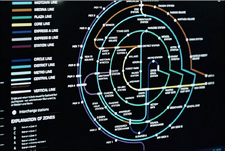Ceres (designated 1 Ceres) is the largest known asteroid and the only Dwarf planet in the Inner Solar System, and the first asteroid discovered by humanity. It lies in the Asteroid Belt.
Ceres Station

Ceres is the site of Ceres Station, a space station that was one of the first sites of human colonization in the Outer Planets. Half a generation after humanity arrived there, Tycho Manufacturing managed to spin up the asteroid, which gave it a gravity of 0.3 g. The station has tens of thousands of kilometers of tunnels.
As the most important port in the Belt, the station has a population of approximately six million permanent residents with an extra one million transiting through at any given time. 800 to 1,000 ships are docked on Ceres every day.
Ceres Station was initially governed by the United Nations (UN) as a protectorate, and station security was handled by the Earth private security firm Star Helix Security.
Ceres Station levels

The gravity on Ceres is not provided by its own mass but by its artificial spin gravity. The level of gravity changes with each level and there is a noticeable Coriolis effect in the lower levels of the station.
Transportation is provided by an extensive tube train network underground.
Ceres Station Districts
- The Medina
- Rosse Buurt
History and events
Eros incident
After the Eros incident, governorship of the station was granted to the Outer Planets Alliance (OPA).
- Main article: Ceres Offensive
- Main article: Free Navy Conflict (TV)
Shortly before or during the continuous Bombardment of Earth by the Free Navy, Ceres Station has come under Free Navy control either voluntarily or by force. Marco Inaros proclaimed Ceres to be the future capital of an independent Belter nation.[2]
- Main article: Ceres Offensive (TV)
With the redeployment of the UNN and MCRN fleets imminent following the capture of the Azure Dragon, the Free Navy stripped Ceres Station bare of life support systems and resources, abandoning it and leaving the civilian population without any supplies and water and air reserves for another three weeks.
A joint EMC fleet of the UN and MCR burned towards Ceres hard, only to find the station abandoned and there for the taking, demanding its immediate and unconditional surrender. Troops of the UNMC and MMC boarded and occupied the Ceres docks without any armed resistance, and, recognizing the impending humanitarian catastrophe on the station, UN Secretary-General Chrisjen Avasarala organized a supply mission of Ceres with military resources and essential goods. Multiple timed hidden explosives left by the Free Navy disrupted the mission however, as the Ceres docks were heavily damaged, water tanks and supplies destroyed. 976 Ceres civilians, and a number of UNMC and MMC troops were killed in the process.[3]Media
Trivia
- Ceres is the Roman goddess of agriculture, who in turn is based on the Greek goddess Demeter. In fact, the word "cereal" is derived from Ceres.
- In the world of The Expanse, Ceres Station is a port city outfitted with thrusters by Tycho MaEC, having spun up Ceres and thus having created centrifugal gravity for long-term living.
- People live inside the planetoid upside down, meaning "up" is towards the center of the planetoid and "down" is towards the surface from within.
- Researchers are uncertain as to how the planets and planetoids have acquired their angular momentum, and how to change it over time is a difficult problem due to their massive size.
- As per the NASA science video above, it is estimated that Ceres is comprised of up to 30% water ice.
- It is mentioned in Season 1, Episode 1 "Dulcinea", that Mars has strip-mined Ceres bare of its ice to support its terraforming enterprise.
- Other materials from the Asteroid Belt that could be mined are titanium, platinum and other precious metals.
See also
References
- ↑ The Expanse Novel Leviathan Wakes - Chapter 18: Miller
- ↑ The Expanse TV series - Season 6, Episode 1: "Strange Dogs"
- ↑ The Expanse TV series - Season 6, Episode 3: "Force Projection"
External links
 Ceres on Wikipedia
Ceres on Wikipedia magazine.artstation.com: Behind the scenes: the concept art of The Expanse (Feb. 2, 2016)
magazine.artstation.com: Behind the scenes: the concept art of The Expanse (Feb. 2, 2016) space.com: Life's Building Blocks Found on Dwarf Planet Ceres (Feb. 16, 2017)
space.com: Life's Building Blocks Found on Dwarf Planet Ceres (Feb. 16, 2017)












